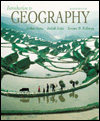 |  Introduction to Geography, 8/e Arthur Getis,
San Diego State University
Judith Getis
Jerome D. Fellmann,
University of Illinois, Urbana-Champaign
Political Geography
Objectives:After reading and studying this chapter you should be able to:
1.
Relate the geographic distribution of national political subdivisions to aspects of cultural diversity.
|
 |  |  | 2.
Differentiate between a state, a nation and a nation-state.
|
 |  |  | 3.
Understand the factors which govern the drawing of political boundaries.
|
 |  |  | 4.
Identify the various shapes which political entities take on and articulate their strengths and weaknesses.
|
 |  |  | 5.
Identify the factors which foster political integration.
|
 |  |  | 6.
Define the various classes of boundaries and be able to classify actual boundaries when presented with a map.
|
 |  |  | 7.
Enumerate the important geographical problems associated with the use of and control over maritime regions.
|
 |  |  | 8.
Identify the landlocked countries of the world and discuss their unique geographical problems.
|
 |  |  | 9.
Know the issues involved in the Law of the Sea Convention and identify the potential problems they pose for
global economic and political geography.
|
 |  |  | 10.
Understand the role international alliances play in global political geography.
|
 |  |  | 11.
Understand the concept of gerrymandering and identify the problems it poses.
|
 |  |  | 12.
List the ways in which local and regional political organization can be fragmented and enumerate the attempts
to overcome political fragmentation of space.
|
|



 2002 McGraw-Hill Higher Education
2002 McGraw-Hill Higher Education